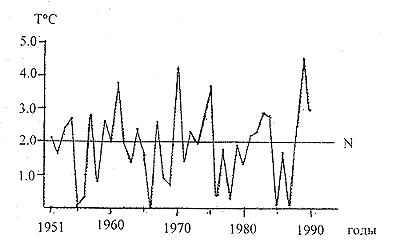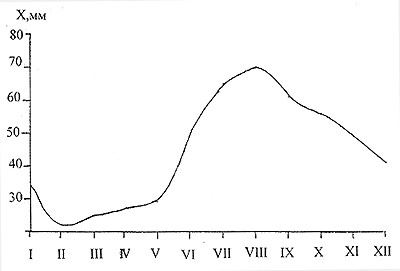The Suojarvi District is situated in the north-west of the temperate belt. The climatic regime in the district is determined by the prevalence of air masses from the Atlantic and Arctic. Atmospheric circulation patterns, solar radiation supply, vicinity of the Baltic, White and Barents seas, a set of local conditions result in unstable weather all year round; a long, but quite mild winter; a late spring with frequent cold rebounds; a short cool summer; high relative air humidity and abundant precipitation.
The winter season is the warmest compared to other districts of Russia located at the same latitude. The snow cover settles in the second half of November - early December, and remains until the 10s-20s of April. Mean monthly air temperature in the coldest month - January - is
-11.3°C in Suojarvi, and -12.4°C in Porosozero. The winter lasts 5-5.5
months - from the third ten days of October through the first ten days of April.
There often occur thaws with a temperature rise to +2...+5°C, often
superseded by abrupt cooling. The absolute air temperature minimum was
-42.4°C in Suojarvi (December 23, 1915), and -43.6°C in Palalahti (January 1940).

Mean annual air temperature (Suojarvi weather station)
N - climatic norm
After April 11-13, mean daily air temperature steadies above
0°C. In May, the temperature rise continues, steadying above +5°C on
May 4-5, and above +10°C - by late May - first days of June. Yet, night frosts are possible until May 31, on average.
The summer is about three months long. The warmest month is July,
when the mean air temperature is +15.9...+16.1°C. The absolute air
temperature maximum is +33.6°C (Suojarvi, July 19, 1916).
First frosts arrive around September 14-15. In the first ten days
of September, the air temperature steadies below +10°C, and by early
October - below +5°C.
Intensive cyclonic activity generates considerable cloudiness in
all seasons. It is the greatest between October and February, with a maximum in
November-December (8.8-9.2 degrees on the 10-point scale of total cloudiness). In spring and summer the amount of clouds decreases to 5.5-6.5 degrees. The number of truly cloudy days (8-10-degree low cloudiness) amounts to 100 over a year. Sunshine duration is about 1600 hours a year; 128 days a year the sun is fully blocked by clouds or fog.
The dominance of SW and S winds over a year is characteristic of the wind regime. Least frequent are NE winds. Average wind velocity is 2.6-2.7 m/sec. The highest velocities are recorded in June (monthly average is 2.9 m/sec). In August 1972, wind in Porosozero reached a threatening velocity of 30 m/sec.

Mean monthly total precipitation (Suojarvi weather station, 1951-90)
In terms of precipitation amounts, the Suojarvi District is classified as an area of excessive moisture supply. Average annual precipitation is 600-700 mm, of which more than 400 mm fall from April through October. Precipitation is the greatest in August, and the lowest - in February.
Expert: L. Nazarova
| 